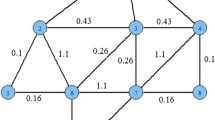Abstract
Sampling from large graphs is an area of great interest, especially since the emergence of huge structures such as Online Social Networks and the World Wide Web (WWW). The large scale properties of a network can be summarized in terms of parameters of the underlying graph, such as the total number of vertices, edges and triangles. However, the large si ze of these networks makes it computationally expensive to obtain such structural properties of the underlying graph by exhaustive search. If we can estimate these properties by taking small but representative samples from the network, then size is no longer such a problem. In this paper we present a general framework to estimate network properties using random walks. These methods work under the assumption we are able to obtain local characteristics of a vertex during each step of the random walk, for example the number of its neighbours, and their labels. As examples of this approach, we present practical methods to estimate the total number of edges/links m, number of vertices/nodes n and number of connected triads of vertices (triangles) t in graphs. We also give a general method to count any type of small connected subgraph, of which vertices, edges and triangles are specific examples. Additionally we present experimental estimates for n, m, t we obtained using our methods on real or synthetic networks. The synthetic networks were random graphs with power-law degree distributions and designed to have a large number of triangles. We used these graphs as they tend to correspond to the structure of large online networks. The real networks were samples of the WWW and social networks obtained from the SNAP database. In order to test that the methods are indeed practical, the total number of steps made by the walk was limited to at most the size n of the network. In fact the estimates appear to converge to the correct value at a lower number of steps, indicating that our proposed methods are feasible in practice.































Similar content being viewed by others
References
Aldous D, Fill JA (1995) Reversible markov chains and random walks on graphs. http://stat-www.berkeley.edu/pub/users/aldous/RWG/book.html
Barabási A, Albert R (1999) Emergence of scaling in random networks. Science 286(5439):509–512
Bawa M, Garcia-Molina H, Gionis A, Motwani R (2003) Estimating aggregates on a peer-to-peer network. Technical Report 2003-24, Stanford InfoLab. http://ilpubs.stanford.edu:8090/586/
Bollobás B, Riordan O (2002) Mathematical results on scale-free graphs. In: Bornholdt S, Schuster H (eds) Handbook of graphs and networks. Wiley-VCH, Weinheim, pp 1–32
Bollobás B, Riordan O (2004) The diameter of a scale-free random graph. Combinatorica 24:5–34. http://dl.acm.org/citation.cfm?id=1005121.1005123
Bollobás B, Riordan O, Spencer J, Tusnády G (2001) The degree sequence of a scale-free random graph process. Random Struct Algorithms 18:279–290
Broder AZ, Kumar R, Maghoul F, Raghavan P, Rajagopalan S, Stata R, Tomkins A, Wiener JL (2000) Graph structure in the web. Comput Netw 33(1–6):309–320
Cheeger J (1971) A lower bound for the smallest eigenvalue of the laplacian. Probl Anal 195–199 (papers dedicated to Salomon Bochner, 1969)
Cooper C (2002) Classifying special interest groups in web graphs. In: RANDOM 2002: Randomization and Approximation Techniques in Computer Science, pp 263–275
Cooper C (2006) The age specific degree distribution of web-graphs. Comb Probab Comput 15:637–661
Cooper C, Frieze A (2003) A general model web graphs. Random Struct Algorithms 22(3):311–335
Cooper C, Frieze A (2007) The cover time of the preferential attachment graphs. J Comb Theory B 97:269–290
Cooper C, Frieze AM (2008) Random walks on random graphs. In: Cheng MX (ed) NanoNet. Lecture notes of the institute for computer sciences, social informatics and telecommunications engineering, vol 3. Springer, Berlin, pp 95–106
Cooper C, Radzik T, Siantos Y (2012) Estimating network parameters using random walks. In: CASoN. IEEE, pp 33–40
Cooper C, Radzik T, Siantos Y (2012) A fast algorithm to find all high degree vertices in graphs with a power law degree sequence. In: WAW 2012 Proceedings. LNCS, vol 7323. Springer, Berlin, pp 165–178
Drinea E, Enachescu M, Mitzenmacher M (2001) Technical report: variations on random graph models for the web. Tech. rep., Harvard University, Department of Computer Science
Ganesh A, Kermarrec A, Le Merrer E, Massouli L (2007) Peer counting and sampling in overlay networks based on random walks. Distrib Comput 20:267–278. doi:10.1007/s00446-007-0027-z
Gjoka M, Kurant M, Butts CT, Markopoulou A (2009) A walk in facebook: uniform sampling of users in online social networks. CoRR. abs/0906.0060
Hastings WK (1970) Monte carlo sampling methods using markov chains and their applications. Biometrika 57(1):97–109
Katzir L, Liberty E, Somekh O (2011) Estimating sizes of social networks via biased sampling. In: Srinivasan S, Ramamritham K, Kumar A, Ravindra MP, Bertino V, Kumar R (eds.) WWW. ACM, pp 597–606
Leskovec J (2009) Stanford network analysis package. http://snap.stanford.edu/
Leskovec J, Backstrom L, Kumar R, Tomkins A (2008) Microscopic evolution of social networks. In: Proceeding of the 14th ACM SIGKDD international conference on knowledge discovery and data mining, KDD’08, ACM, New York, NY, USA, pp 462–470. doi:10.1145/1401890.1401948
Leskovec J, Lang KJ, Dasgupta A, Mahoney MW (2008) Community structure in large networks: Natural cluster sizes and the absence of large well-defined clusters. CoRR. abs/0810.1355
Lovász L (1996) Random walks on graphs: a survey. Bolyai Soc Math Stud 2:353–397
Massoulié L, Merrer EL, Kermarrec AM, Ganesh AJ (2006) Peer counting and sampling in overlay networks: random walk methods. In: Ruppert E, Malkhi D (eds.) PODC. ACM, pp 123–132
Mckinney EH (1966) Generalized birthday problem. Am Math Mon 73(4):385–387. http://www.jstor.org/stable/2315408
Metropolis N, Rosenbluth AW, Rosenbluth MN, Teller AH, Teller E (1953) Equation of state calculations by fast computing machines. J Chem Phys 21(6):1087–1092
Author information
Authors and Affiliations
Corresponding author
Rights and permissions
About this article
Cite this article
Cooper, C., Radzik, T. & Siantos, Y. Estimating network parameters using random walks. Soc. Netw. Anal. Min. 4, 168 (2014). https://doi.org/10.1007/s13278-014-0168-6
Received:
Revised:
Accepted:
Published:
DOI: https://doi.org/10.1007/s13278-014-0168-6




